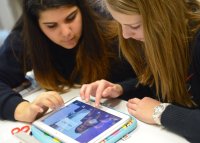Getting Started With Self-Paced Learning
Giving students some control over the pace of their learning can help them develop self-reliance and better problem-solving skills.
Your content has been saved!
Go to My Saved Content.My journey with self-paced learning began when my attempts to implement project-based learning (PBL) failed spectacularly. My students didn’t have the research skills or the self-management skills they needed to cope with PBL, in part because they were trying it for the first time. I needed a way to teach them how to take ownership of their learning and build self-management skills, and I found promise in self-paced learning.
Although my students were uncomfortable with it at first, they adapted quickly and became more engaged. They demonstrated more self-reliance, better problem-solving skills, and better time management. They learned more and retained more, and when I later built in a PBL unit, they were able to complete it successfully.
5 Keys to Self-Paced Learning
1. Tracking student progress: Give students a way to track their own progress. They need a pacing guide to assess whether they’re on track or need extra time in tutoring.
I give students a simple checklist with the unit assignments and a suggested due date for the grading period. This allows them to self-start each day because they know what they’re working on and what their goals are. It also allows them to monitor their pace: If they find that they’ve mastered only two topics by the time I suggest that they should have mastered five, they know they need to come to tutoring.
2. Using flexible groupings: Find ways to partner students who are working on the same assignments. You can do this by having students sit at tables or desk groups designated by assignment or topic in the checklist. When they finish the assignment, they can move to the table designated for the next task.
The groups constantly change, which helps students learn to work with a variety of people outside of their friend group. It also allows group roles to shift organically—students who need extra help on one topic or assignment might find themselves providing help on the next one.
3. Including special populations: Consider using a learning management system (LMS) like Schoology or Canvas so that you can accommodate students in special education and English language learners discreetly (e.g., by adjusting their assigned workload in accordance with an IEP or adding subtitles to any videos). If a student’s IEP calls for extra time, for example, an LMS allows you to adjust the allotted time on a quiz or test or an assignment due date for that individual student.
If you have students with modified standards, you can adapt an assignment or the questions on a test to reflect those modifications without calling attention to them. And using an LMS where all assignments are accessible at any time allows my English language learners to preview material before I talk about it, and it allows me to build in language supports such as a glossary or sentence stems.
4. Assessing learning: Build individual assessments into each topic, but also bring heterogeneous groups together to work on small, authentic problem-solving tasks based in the unit. At the beginning of each class I give my students a mini-lab or multilevel problem to complete in random groups, which mix students who are behind the suggested pace, on pace, and ahead of the suggested pace. To assess learning, I circulate among the groups and listen for any misconceptions or points of confusion that still need to be addressed.
As the groups work together, students who are working ahead have a chance to teach the concept to others, students who are on pace receive reinforcement and clarification, and students who are behind pace can ask questions about the concept. Student groups also benefit from sharing out in a whole-class discussion, where they can see different ways to address the same problem.
5. Pushing for mastery: Encourage students to do their best work in the time they have. My grades lock at the end of every grading period (every five to seven weeks), and my district discourages making changes after that—my students have to finish their checklist within that time frame. There’s only so much perfectionism they can indulge in before they need to move on, but they don’t need to do sloppy work in order to race the clock.
I have some “finishers” in my class—students who try to race through, completing the bare minimum to pass or finishing assignments without returning to missed concepts. To discourage this, I refuse to accept work that is clearly rushed, and I don’t record a grade until students demonstrate mastery of the concept I’m assessing. If I find misconceptions or gaps in their understanding, I return the work with feedback for them to fix and repeat until I see that they’ve reached a deeper understanding.
This process takes more time than batch grading, and it means I need to keep track of multiple answer keys at any given time as students reach different assessment points at different times, but I’ve found that the benefits outweigh the extra work. As the year progresses, students begin double checking their work before handing it in, and they turn in better quality work.
Trying It Yourself
Although my students are uncomfortable with learning this way at the beginning of the year, by the end they’re astonished at how much they have learned and retained.
You should try out self-paced learning with one unit first. Start with a unit that previous students have easily grasped—shifting to self-paced learning can be a massive learning curve for both the student and the teacher, so it’s best to begin on a topic where you can commit brainpower to the new processes. Then when you do this with a harder unit, students can really engage with the new material because they have the self-paced processes down already.
